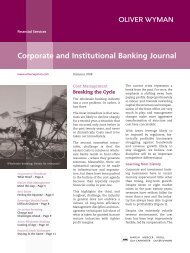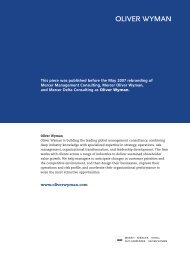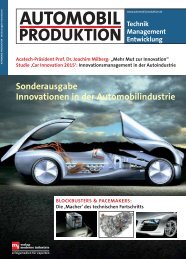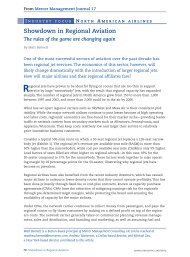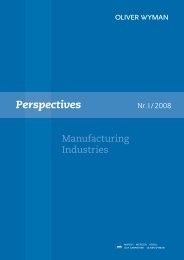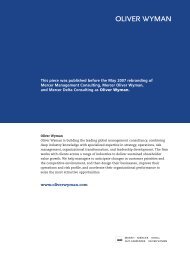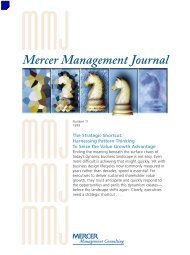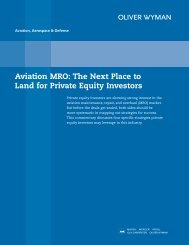Demand innovation: GM's OnStar case - Oliver Wyman
Demand innovation: GM's OnStar case - Oliver Wyman
Demand innovation: GM's OnStar case - Oliver Wyman
Create successful ePaper yourself
Turn your PDF publications into a flip-book with our unique Google optimized e-Paper software.
But pursuing this goal would require breaking with the traditional car industry culture. It would<br />
also mean ‘‘giving’’ competing rms a proprietary technology that GM had spent millions of<br />
dollars to develop. Most important, it would mean changing the relationship between the parent<br />
company and its offspring. <strong>OnStar</strong> would have to become a connected-yet-independent<br />
business free to work with automakers other than GM in markets around the world, to build its<br />
own customer base, and to develop and promote its own brand name.<br />
Breakout<br />
In early 1999, GM’s leadership made two tough choices. One was to make <strong>OnStar</strong> a factoryinstalled<br />
option on a wide array of new GM vehicles, not just on Cadillacs. By mid-2002, <strong>OnStar</strong><br />
was available on 38 of GM’s 52 models. The other was to pursue the goal of making <strong>OnStar</strong> the<br />
de facto standard of the new in-vehicle services business, available through multiple carmakers.<br />
Today, <strong>OnStar</strong> is available on cars made by Lexus (Toyota’s luxury brand), Audi, Acura, Isuzu,<br />
Saab, and Subaru, with more automakers coming online every year. In combination, these<br />
moves produced a dramatic growth explosion for <strong>OnStar</strong>.<br />
By early 2002, more than 2 million vehicles were equipped with <strong>OnStar</strong>, as compared to fewer<br />
than 50,000 three years earlier. This gure is forecast to grow to over 4 million by the end of this<br />
year.<br />
Challenges to come<br />
GM’s vision for <strong>OnStar</strong> does not stop with its rst-generation safety and security and diagnostic<br />
services. A key element of the company’s growth strategy is to build out from a new business<br />
platform once it begins to show promise. For example, <strong>OnStar</strong> has launched several new<br />
services since 2001. One is Personal Calling, a hands-free mobile phone service in partnership<br />
with Verizon. This opens the door to a new prot stream for <strong>OnStar</strong> via the buying and reselling<br />
of cell phone minutes – in fact, <strong>OnStar</strong> is already the largest cellular service reseller in the<br />
country. Another is Virtual Advisor, a customized, voice-activated information service that<br />
provides drivers with trafc and weather reports, sports scores, stock quotes, and even delivery<br />
of e-mail messages read aloud by an automated voice. It’s a prototype of the information and<br />
entertainment services that could end up as commonplace parts of the mobile services bundle.<br />
GM is starting to build additional services into <strong>OnStar</strong>, ranging from mobile transactions and<br />
in-vehicle entertainment to dynamic trafc and route assistance. GM has invested in XM Radio,<br />
a satellite radio system offering 100 digital channels of music, news, and chat for a monthly<br />
subscription fee.<br />
Measuring <strong>OnStar</strong>’s success<br />
The crucial factors in GM’s success have been its ability to look at customers’ driving needs<br />
from a fresh perspective and its decision to serve these needs through a business design that<br />
leverages GM’s unique hidden asset – its unequaled installed base of vehicles.<br />
While <strong>OnStar</strong> is just now maturing as a business model, it is on its way to becoming one of<br />
those high-impact growth opportunities that GM has sought. <strong>OnStar</strong> is approaching $1 billion in<br />
Taking a page from <strong>OnStar</strong>’s playbook<br />
If you work in a traditional product-centered manufacturing rm, there may be a signicant growth<br />
opportunity in the areas surrounding your product’s installed base. Here are some relevant questions:<br />
# Alistair Davidson. www.alistairdavidson.com<br />
f<br />
f<br />
f<br />
GM found new, unmet needs in an otherwise mature industry by expanding its view of the market.<br />
Can you identify one or more adjacent market spaces with high-intensity growth and prot potential?<br />
<strong>OnStar</strong> sought to address the emotional and empowerment issues associated with improving the car<br />
driving experience. Do your customers have ‘‘soft’’ emotional needs that might be addressed in<br />
innovative ways?<br />
GM’s installed base represents an asset that would be virtually impossible for a new competitor to<br />
replicate. Does your core business generate any assets that are similarly difcult to match?<br />
VOL. 31 NO. 4 2003<br />
|<br />
STRATEGY & LEADERSHIP<br />
|<br />
PAGE 21



